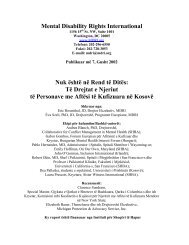Torture not Treatment - Disability Rights International
Torture not Treatment - Disability Rights International
Torture not Treatment - Disability Rights International
You also want an ePaper? Increase the reach of your titles
YUMPU automatically turns print PDFs into web optimized ePapers that Google loves.
TORTURE NOT TREATMENT<br />
<br />
<br />
<br />
<br />
<br />
<br />
<br />
<br />
<br />
<br />
<br />
48 students receiving electric shock for over 5 years; the use of shock for ‗destroying,<br />
major disruptive, and non-compliance; 214<br />
only 23 of 105 treatment plans received the required annual review by JRC‘s Human<br />
<strong>Rights</strong> Committee (HRC); 215<br />
JRC‘s Human <strong>Rights</strong> Committee failed to meet its regulatory requirement of conducting<br />
quarterly meetings; 216<br />
the failure to meet resulted in an inadequate opportunity to properly oversee rights issues<br />
in Level III behavioral plans; 217<br />
HRC failed to review any emergency restraints used for 2 years; ‗Irregularities‘ in<br />
mechanical restraint practices (referred to in the report as ‗Limitation on Movement‘ or<br />
LOM) such as authorizing restraint devices for medical reasons; no waivers or approvals<br />
from DMR existed for these devices as required; undocumented restrictions for<br />
visitations, possessions and locked buildings [residences]; 218<br />
the use of Level III punishments for ‗relatively minor behaviors‘ remains problematic;<br />
concern that the impact of physical disability or acute illness might have on ‗ problem<br />
behavior‘ or ‗targeted negative behavior‘ which would result in punishment; seemingly<br />
minor behaviors punished with electric shock; 219<br />
student described as having anxiety but <strong>not</strong> treated with behavioral interventions<br />
commonly used to treat anxiety; 220<br />
absence of explanation of which authorized Level III punishment used; labeling noncompliance<br />
as a behavior was <strong>not</strong> acceptable; 221<br />
Level III punishment for minor behaviors and the argument that these minor behaviors<br />
are antecedent to more dangerous behaviors must be augmented with more data<br />
demonstrating this relationship; 222<br />
Limitation of Movement [restraint] interventions must be treated as Level III aversives<br />
and documented accordingly; 223<br />
plans routinely refer to the use of helmets as ‗health related protection,‘ authorized by a<br />
physician. When LOM is included in a treatment plan, there must be specific<br />
individualized data to support its inclusion. 224<br />
JRC was granted a six month certification to use Level III aversives. The DMR report cited<br />
partial compliance to state regulations, previous recommendations and conditions. The state<br />
promised to work with JRC to address the deficiencies and assist JRC in developing a<br />
―monitoring plan‖ for compliance. Additionally, certification was subject to full compliance in<br />
the areas of: improved behavioral plans subject to the specific needs of the individual students;<br />
explanation for increase/decrease in effectiveness of Level III aversives and a plan to fade<br />
(discontinue) the use of aversives; rationale for using Level III aversives on minor behaviors; an<br />
outside expert engineering and medical report on the safety of the GED devices; mandate that the<br />
Peer Review Committee meet with the frequency required by state regulation; mandate that the<br />
40




